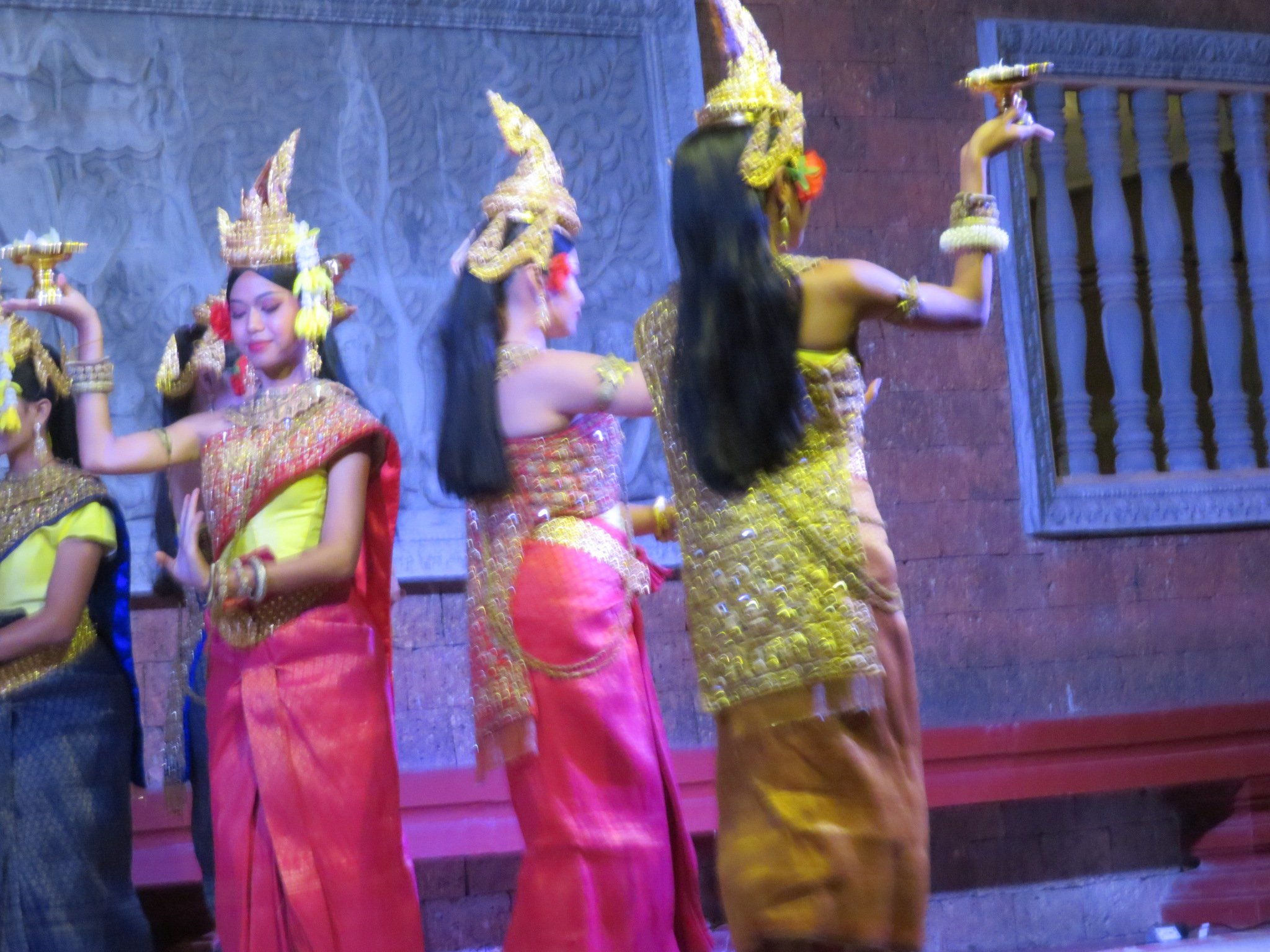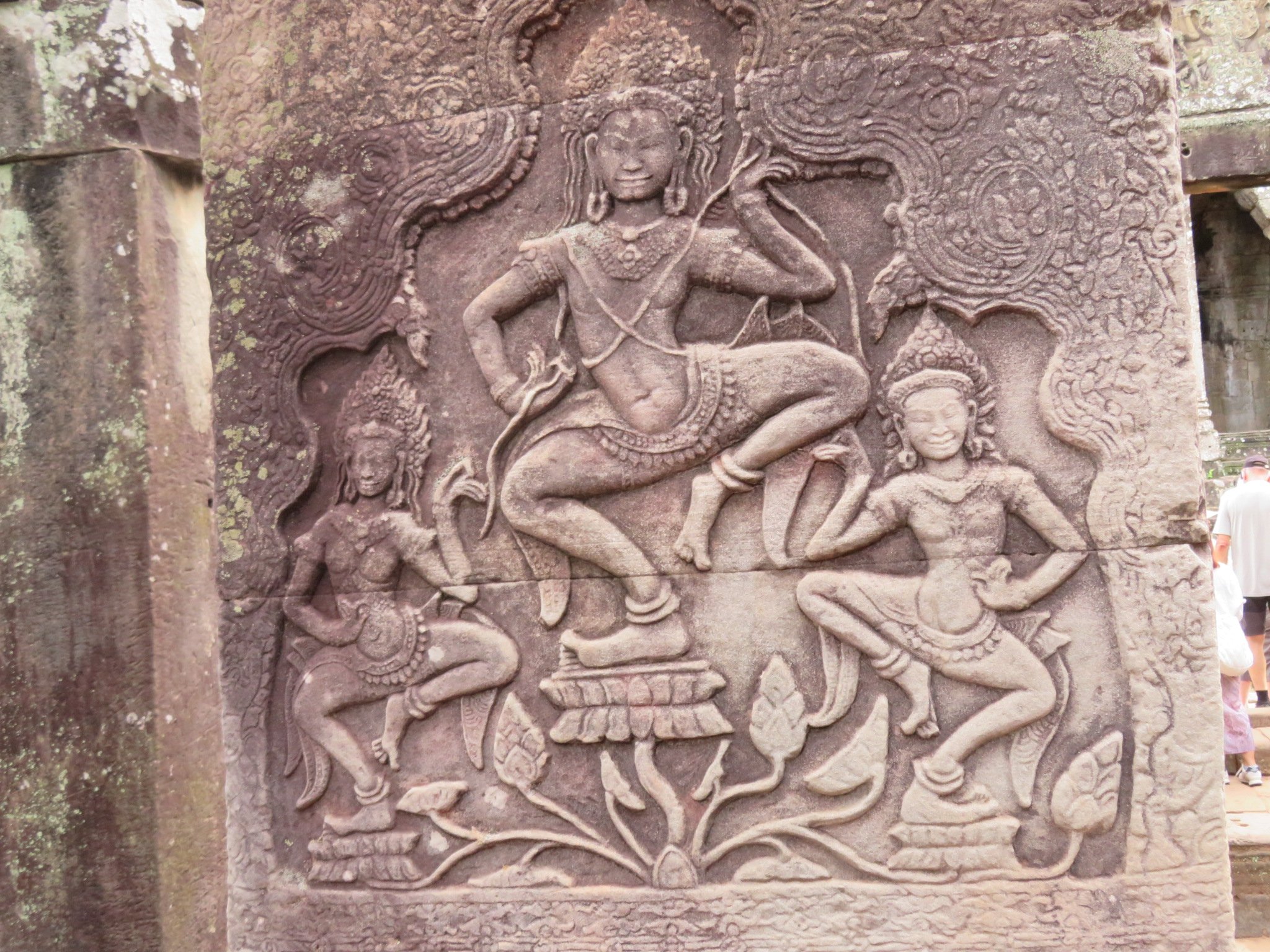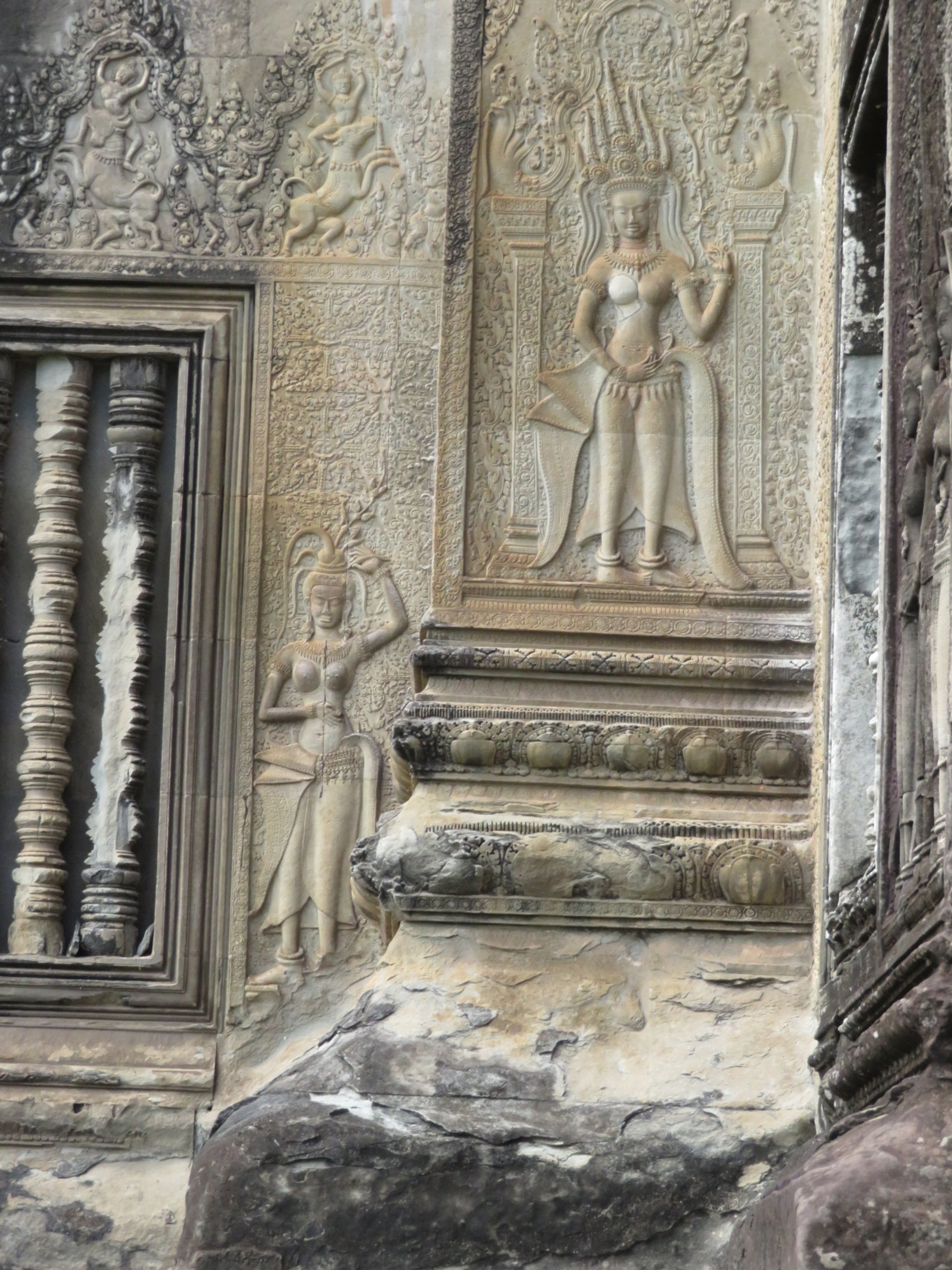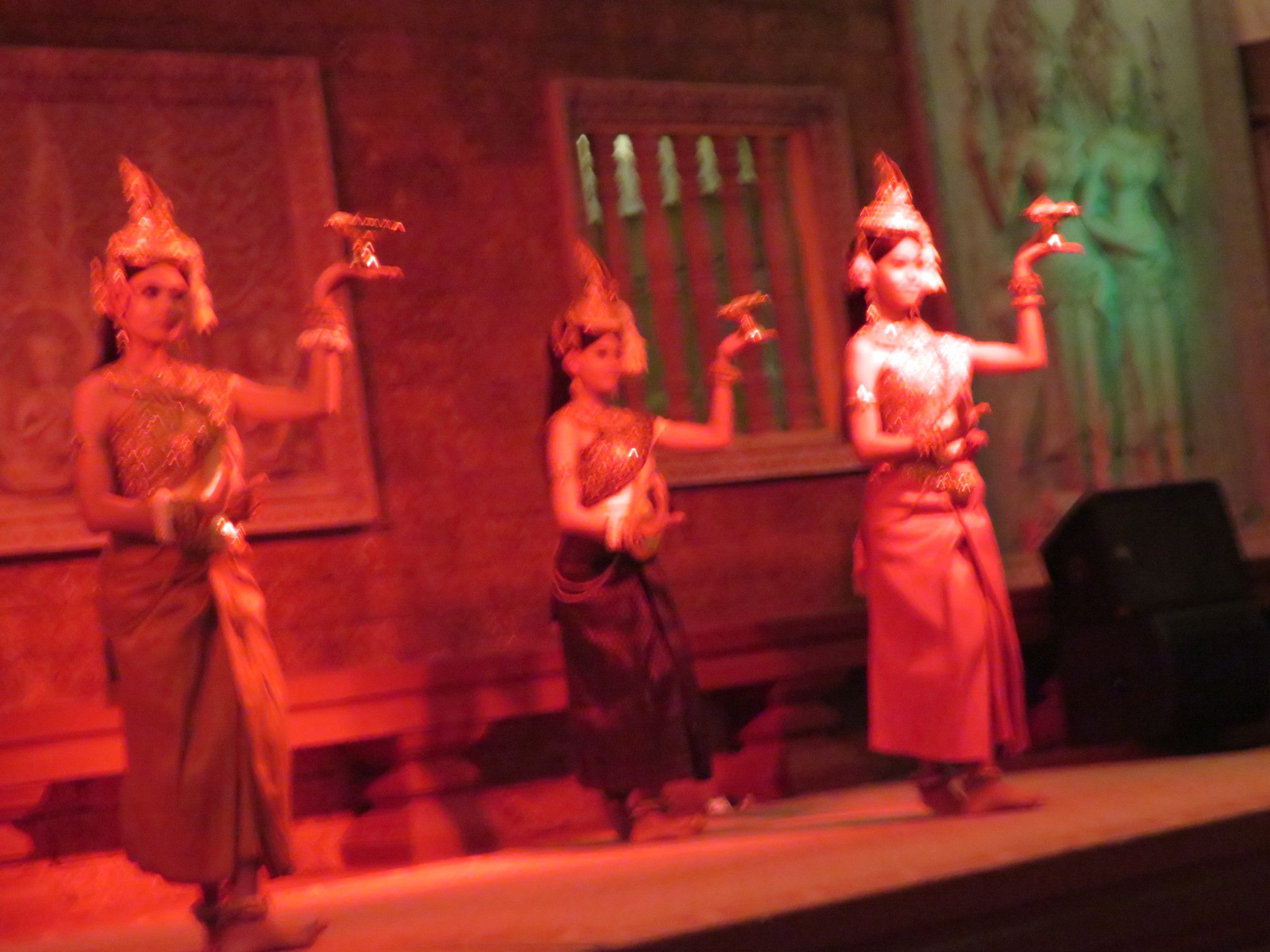A Blessing in Motion
By Carolyn Handler Miller
Around my right wrist is a piece of red yarn. It’s a little frayed and the ends are tangled, but I cherish it. I acquired this modest piece of yarn in Cambodia about three months ago and have never considered cutting it off. It is a Cambodian symbol signifying that I have been blessed.
The yarn was tied around my wrist during a traditional performance of Apsara dancing, an ancient form of Cambodian ballet. My husband Terry and I had learned about the dance performance after returning to our hotel in Siem Reap from an intense day of sightseeing just a few hours before it was to begin. Tired as we were, we felt we would later regret not attending, so we signed up for it. It was to take place with an accompanying dinner right at our hotel, the timeless Raffles, close to Angkor Wat.
The importance of Apsara dancing to Cambodian tradition is impossible to miss when visiting the nearby temple complex, because beautiful carvings of the performers, the Celestial Dancers, as they are called, are abundant on the walls. At one time, only members of the royal Cambodian court and special guests were allowed to witness Apsara dancing, but now anyone, even Western tourists like my husband and me, is welcome to see it.
Dating back to the seventh century, Apsara dancing is an elegant form of Asian ballet. According to mythology, the Celestial Dancers represent beautiful creatures who came down from the heavens to entertain the king and his family. It is a cherished part of Khmer tradition that almost disappeared during the horrors of the Khmer Rouge bloodbath during the 1970s but was revived during peaceful times by a royal daughter, Princess Bopha Devi.
The night of the performance, only a few other visitors were fortunate enough to be present, possibly because the hotel had not promoted it. The lack of a big crowd, however, created a wonderful sense of intimacy with the dancers and musicians.
The MC for the evening welcomed us and informed us that the first dance would be the Blessing Ceremony, and much to our surprise told us the dancers themselves would personally honor us with the traditional blessing symbol. Suddenly a line of gorgeously costumed and bejeweled young female dancers emerged from behind the stage to greet us. The closer they got, the more splendid they looked, with tall, regal headdresses, gleaming jewelry, and shimmery silk dresses.
All at once I was standing face to face with these dazzling creatures. They indicated that I should extend my arm, and then carefully tied my wrist with a strand of red yarn. Now I wasn’t just a viewer, but immersed in the ritual. Once each of the other audience members was similarly adorned, the dancers mounted the stage and performed the Blessing Ceremony, holding gilded bowls of flowers as they danced. I watched them in a haze of otherworldly serenity, welcoming the message of the dance: happiness, prosperity, good health and success. It was a blessing in motion.
The dancers were unlike any I had seen before, aside from the carvings on the Cambodian temple walls, whom they resembled exactly. They moved slowly and purposefully, often balancing on one foot while bending the other leg back at a precarious angle. Their graceful hand movements were astonishing. They had the ability to bend their wrists so that their hands almost touched the backs of their arms, meanwhile making intricate gestures with their fingers. Each gesture had a meaning, though being so new to Apsara dancing, I could not interpret them. I only knew that their gestures and movements were meant to bless us.
Being blessed is like receiving a special gift from the beyond. Before coming to Cambodia, I had only been blessed a handful of times. The first blessing was given to me by my Rabbi during my Jewish confirmation, and the second at my wedding to Terry, when my matron of honor recited an Irish blessing. I was also blessed during a Catholic mass, when the priest invited those of us who were not taking Communion to join the line of congregants and indicate our desire to be blessed by crossing our arms. I was also blessed twice at different holy places in India, once in a Hindu temple and another in a Sikh gurudwara.
I don’t believe that only members of the clergy can bestow a blessing. Some of the blessings I’ve received have been given by lay people, and they were just as treasured as the ones from religious professionals. I believe the essential element of a blessing is the intention of the blesser to convey positive benefits to the person being blessed, and for the recipient to being open to being blessed. Thus, with a successful blessing, an other-worldly exchange takes place.
While we were inside of Angkor Wat, I observed a monk in an orange robe offering blessings to Temple visitors. I would have loved to have received a blessing from him, but I was dealing with broken toes at the time and could not manage to descend to the low chamber where he sat. However, I was close enough to see that at the end of each blessing he would also tie a piece of red yarn to the blessed person’s wrist. It was just like the one on my wrist.
Each of the blessings I’ve received has been unique, and none is more unique than at the Apsara Blessing Ceremony, the blessing in motion. With each blessing, I’ve felt a sense of peace and sweetness wash over me. Yet the Apsara blessing stands out from the others because it offered me a unique chance to be immersed in an ancient, 1300-year-old Cambodian tradition, connecting deeply with something authentic. Moreover, it was a precious moment out of my secular life and a chance to be in the world of the spirit. And that is why the red yarn is still around my wrist, so I can hold onto this sensation and this memory for as long as possible.
Carolyn Handler Miller (www.carolynhandlermiller.com) is a writer who works across a variety of media. Originally beginning her career as a newspaper reporter and magazine journalist, Carolyn's projects span TV shows and specials, feature films, books and new media. She is one of the pioneering writers in the field of interactive narrative, where she has contributed to over 50 projects as a writer, writer-story designer, and consultant. She is the author of “Digital Storytelling: A Creator's Guide to Interactive Entertainment” (Focal Press), now in its fourth edition.







